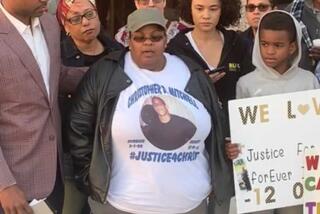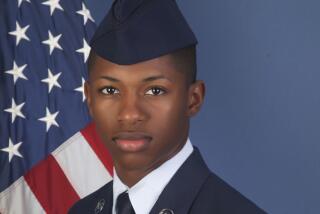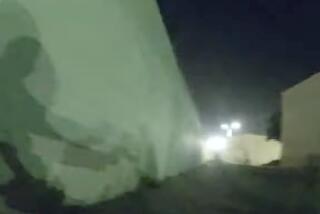Deputy who shot airman was ‘forced to,’ defense says
- Share via
On the night a San Bernardino County deputy sheriff shot an unarmed airman after a 100-mph chase, he was in a strange location with no backup, straining to hear his police radio while keeping his eyes trained on two men he believed “were willing to die rather than get caught,” the deputy’s lawyer said Tuesday.
Although Ivory John Webb Jr.’s tactics were flawed and his commands were unclear, Webb “committed no crime” when he shot Elio Carrion as the airman was lying on the ground, his attorney told jurors during opening arguments at the San Bernardino County Courthouse on Tuesday.
“My client did not want to shoot -- he didn’t want to use his weapon that night,” Michael Schwartz said. “He didn’t want to until he felt he was forced to.”
Both sides made it clear that the key piece of evidence would be the grainy videotape of the incident a bystander filmed. They said they intended to analyze the video repeatedly, frame by frame. The case, it appears, will probably rest on jurors’ interpretations of the footage and what was going through Webb’s mind when he appeared to order the airman to “get up” before he shot him.
Webb, the first San Bernardino County law enforcement officer charged in an on-duty shooting, is on trial for attempted voluntary manslaughter and assault with a firearm for shooting Carrion, an Air Force police officer who was home on leave after serving in Iraq. He has pleaded not guilty to all charges and could face more than 18 years in prison if convicted.
Webb, 46, left the Sheriff’s Department last year, and the department will not say whether he resigned or was fired.
Schwartz told the jury that Webb fired because he believed his life was in danger when he saw Carrion slide his hand inside his oversized Oakland Raiders jacket.
Deputy Dist. Atty. R. Lewis Cope, who argued that the shooting was unprovoked, urged the jury to look beyond isolated freeze frames of Carrion’s movements on the tape to the totality of the evidence against Webb.
The deputy never mentioned his fear that Carrion carried a weapon when he gave his first version of the shooting to investigators, Cope said. The prosecutor said Webb initially said Carrion disobeyed his orders to stay on the ground and that he shot him three times because Carrion “got up and lunged toward him,” Cope said.
“There’s no mention of seeing a gun or weapon of any kind,” Cope told the jury. “Mr. Webb -- if he were a reasonable, ordinary person in uniform ... knew he was not under threat.”
Carrion, who is back on light duty at Barksdale Air Force Base in Louisiana after 3 1/2 months of physical therapy, is expected to testify today.
The events leading to the shooting began the afternoon of Jan. 29, 2006. Carrion and high school friend Luis Escobedo, who were both 21, were intoxicated after a barbecue at Carrion’s parents’ house to celebrate the military police officer’s safe return from a six-month tour in Iraq and the end of a 30-day leave.
Escobedo, who was driving with a suspended license, borrowed a blue Corvette from a friend and took off for a late-night spin with Carrion in the passenger seat.
Escobedo has pleaded guilty to evading a peace officer and driving under the influence that night. He is serving a six-month sentence. Carrion was not charged.
During the ride through Chino and Montclair, Escobedo sped past a deputy at more than 100 mph. The deputy gave chase but couldn’t catch the Corvette. Webb heard about the speeding car over the radio and took over the pursuit.
The chase ended when the Corvette hit a dip on Francis Avenue in Chino, jumped a curb, swiped a fence and rolled into a wall.
Escobedo remained in the driver’s seat, but Carrion jumped out the passenger side and lay beside the Corvette to make Webb feel he was in control, the prosecutor said.
On the video, Webb is standing over Carrion with his gun drawn and his flashlight shining on his face. Webb repeatedly shouts at them to “shut up” but they continue talking back.
Carrion, who is gesturing with one of his hands as he talks in the darkness, tells Webb that he and Escobedo “mean you no harm” and are “on your side,” lawyers for both sides agreed.
Carrion says he is in the military and has more police training than Webb -- statements Webb’s attorneys say the deputy viewed as threats to his authority.
The prosecution and defense clashed over where Carrion’s hands were just before the shooting. Cope argued that Carrion’s hands were in plain view touching the ground just before he followed what he heard to be Webb’s order to “get up” -- and pushed himself off the ground with both hands.
Schwartz emphasized that throughout the encounter, one of Carrion’s hands was often in motion, either gesturing or at two points reaching toward Webb “within inches of his weapon.” The two sides also foreshadowed a central argument over exactly what orders Webb gave and what he meant before he fired.
Cope told jurors Tuesday that Webb clearly told Carrion to “get up” twice.
Illustrating Webb’s motions by holding a brown toy gun and heavy flashlight pointed in front of him, Cope argued that Webb underscored the command “get up” by moving his gun up and down as he said the phrase “as if Mr. Carrion is being told with the motion of the gun to get up,” Cope said.
Schwartz told the jury that regardless of what Webb said, he believed he was telling Carrion to get his hands back on the ground where Webb could see them.
“What my client saw and heard at that time will always be in dispute,” Schwartz said. “In that position -- in that level of fear -- no human being is held to a standard of having to articulate perfectly.”
More to Read
Sign up for Essential California
The most important California stories and recommendations in your inbox every morning.
You may occasionally receive promotional content from the Los Angeles Times.











